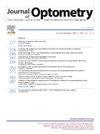Effect of high-energy visible light–filtering spectacle lenses on high and low contrast distance visual acuity
IF 1.8
Q2 OPHTHALMOLOGY
引用次数: 0
Abstract
Purpose
High-energy visible (HEV) light has been the subject of considerable debate recently despite its critical role in several physiological functions. High-energy visible light–filtering spectacle lenses, which attenuate transmission of HEV light, are being widely marketed as protective measures for ocular health and interventions to improve visual function and sleep quality. This study reports on the effect of HEV light–filtering spectacle lenses on high and low contrast (10 % and 2.5 %) distance VA.
Methods
High and low contrast binocular distance VA was measured in 30 young adults in photopic and mesopic illumination. The VA measurements were taken with four test lenses including three commercially available HEV light–filtering lenses and a control lens. Data were analysed with descriptive and inferential statistics.
Results
There was no significant difference in mean photopic high contrast (F(2.5, 73.5) = 1.30, p = 0.28), low contrast 10 % (F(3, 87) = 0.24, p = 0.87) and 2.5 % (F(3, 87) = 0.72, p = 0.54) VA measurements with the four test lenses. Similarly, in mesopic illumination the mean VA measurements were similar among the four test lenses (high contrast (F(3, 87) = 1.06, p = 0.37), low contrast 10 % (F(3, 87) = 0.70, p = 0.55) and low contrast 2.5 % (F(3, 87 = 0.49, p = 0.69)).
Conclusion
The HEV light–filtering spectacle lenses produced no meaningful changes in VA compared with the control lens in varying illumination. Eye care personnel should consider this information when considering HEV light–filtering spectacle lenses in clinical practice.
高能量可见光滤光眼镜镜片对高、低对比距离视力的影响
目的高能可见光(HEV)在多种生理功能中发挥着关键作用,但近年来一直是争论的主题。高能可见光过滤眼镜镜片可减弱HEV光的透射,作为眼健康保护措施和改善视觉功能和睡眠质量的干预措施被广泛推广。本文报道了HEV滤光眼镜镜片对高、低对比度(10%和2.5%)距离VA的影响。方法测定了30例青年人在光和中聚光条件下的高、低对比度双眼VA。VA测量是用四个测试透镜进行的,包括三个市售的HEV滤光透镜和一个控制透镜。数据分析采用描述性和推断性统计。结果四种测试镜片的平均光性高对比度(F(2.5, 73.5) = 1.30, p = 0.28)、低对比度10% (F(3,87) = 0.24, p = 0.87)和2.5% (F(3,87) = 0.72, p = 0.54) VA测量值无显著差异。同样,在介观照明下,四种测试透镜的平均VA测量值相似(高对比度(F(3,87) = 1.06, p = 0.37),低对比度10% (F(3,87) = 0.70, p = 0.55)和低对比度2.5% (F(3,87) = 0.49, p = 0.69))。结论在不同照度下,HEV滤光眼镜镜片与对照镜片相比VA无明显变化。眼科护理人员在临床使用HEV滤光眼镜镜片时应考虑到这些信息。
本文章由计算机程序翻译,如有差异,请以英文原文为准。
求助全文
约1分钟内获得全文
求助全文

 求助内容:
求助内容: 应助结果提醒方式:
应助结果提醒方式:


